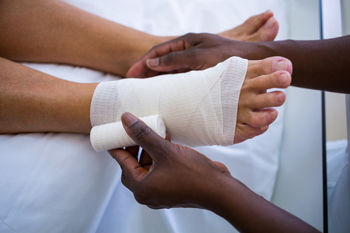
Wound healing occurs when repair is done for skin damage. The first response from the body is known as the hemostasis phase, which happens as the injury occurs. This is the body’s natural response for wound care, as it stops any bleeding or fluids. Wounds can range from superficial to serious, and there are three types of wound care that are applicable, depending on what type of wound it is. Some wounds require staples, stitches or glue, and these are classified as primary wound healing. A large amount of tissue loss may result in having secondary wound healing performed. This is done when the wound is too large to stitch, or if the wound is in a place where stitches would be uncomfortable. Wounds that are infected may require a tertiary wound healing procedure, which is the delayed closure of a wound so proper drainage can take place. If you have a wound on your foot, it is strongly suggested that you speak with a podiatrist as quickly as possible who can determine what the proper type of wound care is for you.
Wound care is an important part in dealing with diabetes. If you have diabetes and a foot wound or would like more information about wound care for diabetics, consult with Tanisha Richmond, DPM from Richmond Foot & Ankle, LLC. Our doctor will assess your condition and provide you with quality foot and ankle treatment.
What Is Wound Care?
Wound care is the practice of taking proper care of a wound. This can range from the smallest to the largest of wounds. While everyone can benefit from proper wound care, it is much more important for diabetics. Diabetics often suffer from poor blood circulation which causes wounds to heal much slower than they would in a non-diabetic.
What Is the Importance of Wound Care?
While it may not seem apparent with small ulcers on the foot, for diabetics, any size ulcer can become infected. Diabetics often also suffer from neuropathy, or nerve loss. This means they might not even feel when they have an ulcer on their foot. If the wound becomes severely infected, amputation may be necessary. Therefore, it is of the upmost importance to properly care for any and all foot wounds.
How to Care for Wounds
The best way to care for foot wounds is to prevent them. For diabetics, this means daily inspections of the feet for any signs of abnormalities or ulcers. It is also recommended to see a podiatrist several times a year for a foot inspection. If you do have an ulcer, run the wound under water to clear dirt from the wound; then apply antibiotic ointment to the wound and cover with a bandage. Bandages should be changed daily and keeping pressure off the wound is smart. It is advised to see a podiatrist, who can keep an eye on it.
If you have any questions, please feel free to contact our office located in Dayton, OH . We offer the newest diagnostic and treatment technologies for all your foot care needs.